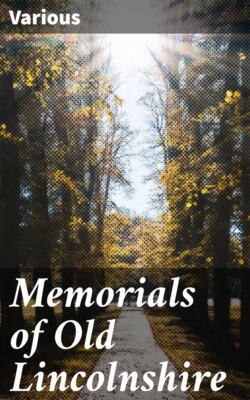Читать книгу Memorials of Old Lincolnshire - Various - Страница 5
На сайте Литреса книга снята с продажи.
PREHISTORIC LINCOLNSHIRE
ОглавлениеTable of Contents
By the Rev. Alfred Hunt, M.A.
That part of England which we now know as Lincolnshire passed through great changes in its surface before the advent of mankind.
The rocks which lie beneath the surface soil in this county are all made by deposit, for several thousand feet in thickness, and are what are called stratified rocks. They indicate the fact that in past periods of time Lincolnshire was all under a great sea. Occasionally in the limestone rocks are found small branches or pieces of trees, as well as great quantities of fossils of many kinds. The fact that oak and silver birch twigs are found inside the limestone shows that trees were growing elsewhere when the rocks were being laid down by the action of water in Lincolnshire.
Beneath the limestone are found thick beds of red sandstone, while still deeper down, over 3000 feet below the surface, lie beds of coal in the north-western part of the county—indicating vast changes in the land since what is now coal was first formed.
After the deposit or formation of these thick beds of rock, the land seems to have been raised above the surface of the sea, to be in turn covered with vast sheets of ice, called glaciers.
These glaciers extended all over Lincolnshire and up into North Britain above Aberdeen in the one case, and joined another vast glacier stretching right across what is now called the North Sea to land which is known to-day as Norway.
These glaciers carried on their surface blocks of rock of many kinds, some of an igneous nature, and as the glaciers moved slowly the fragments of rock were carried many miles from their original source. As the ice melted, these blocks of rock fell to the ground, and are now found all over Lincolnshire.
The time when these glaciers of Britain melted away is given by Lord Avebury[1] as about fifty thousand years ago, but they “may have lingered among the mountains, and occupied some of the valleys down to a much more recent period.”
The deepest borings in Lincolnshire have not yet reached the fiery or igneous rocks in situ, except in the Isle of Axholme; therefore those fragments of igneous rocks found on the surface, or in the soil, or in glacial clays, indicate that they have been transported from their original source, which, in certain instances, is as far distant as Norway.
Since the melting of the most recent glacier, other great changes have taken place in the surface of the land, owing to elevations and depressions, and the action of rain, frost, and denudation over wide areas.
A vast forest (now submerged) formerly existed right along the edge of the east coast of Lincolnshire; at specially low tides it is seen exposed at Chapel St. Leonards, Ingoldmells, and other places on the East Coast.
When the Romans came to Britain, and began their conquest or occupation of Lincolnshire, A.D. 50, they found extensive portions in the south-east of the county covered by great meres stretching many miles in extent. In the south-western part of the county were extensive forests; in the north-western part of the county was the island, now called the Isle of Axholme; but during the Roman occupation, and for centuries afterwards, were vast sheets of fresh water, with here and there an island or islet standing out above the surrounding meres. On the eastern side of the county, along the sea-board, the Romans built extensive banks or sea walls.
Prior to the Roman occupation of Lincolnshire, a race or different races of people lived in the land we now know as the county of Lincolnshire; and it is of this period that we write regarding the earliest known races of mankind in the county.
The different races of mankind in the Prehistoric Ages or Periods have been tabulated as—
1. The Eolithic Man, or Dawn of the Stone Age.
2. The Paleolithic Man, or the Old Stone Age, subdivided by Professor Dawkins as (a) The River Drift Man and (b) Cave Man.[2]
3. The Neolithic Man, or New Stone Age.
4. The Pygmy Man.
5. The Bronze Age, subdivided as Early and Late Bronze Periods.
6. The Prehistoric Iron Age.
7. The Iron Age of the Roman Period.
We will deal with each of these races separately as they concern Lincolnshire.
